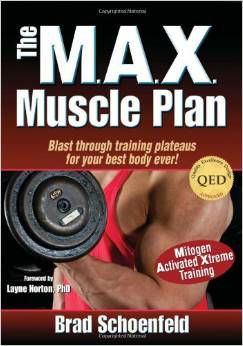Tom Venuto Book Club #2: The Max Muscle Plan by Brad Schoenfeld. Category: Muscle and Strength.
 “The perfect blend of art and science in a step by step practical muscle building program.”
“The perfect blend of art and science in a step by step practical muscle building program.”
I first met author Brad Schoenfeld in 2008 at a conference in New York City. In 2012, I received an early copy of The MAX Muscle Plan prior to publication to read for possible endorsement, which I enthusiastically provided (you can see my blurb on the back cover and in the Amazon.com editorial reviews). Since then, I’ve wanted to add a detailed book review, and finally here it is.
Schoenfeld, who recently earned a PhD in applied exercise science, has built a reputation as one of the top experts on the mechanisms of muscle hypertrophy. Knowing his background beforehand, I was expecting The MAX Muscle Plan to be very science-heavy and read like a research journal article.
However, when I started reading, I realized that the bulk of the information in the book is practical exercise instruction and step-by-step workout plans. It’s perfect for the average trainee who just wants to be told what to do in the gym, and do it knowing the program is grounded in science.
In chapter 1, The Science of Muscle Development, Brad gives you a concise summary of what the latest research says about the physiology of muscle growth and how to trigger it Chapter 2 continues by explaining the concept of periodization. Periodization is a term used to describe the science (and art) of planning out phases or blocks of training over an extended period, strategically implementing changes in all the major training variables at just the right time. The goals are to improve recovery, achieve steady progress, reduce stagnation, eliminate boredom and avoid injury.
The workouts in the MAX Muscle plan are set up in cycles that typically last four weeks. Each block has a consistent focus such as strength, hypertrophy or metabolic effect which calls for month to month changes in training variables including load, volume, rest intervals, effort, repetition speed, exercise choice and training frequency. The plan also uses the undulating periodization model, where some of the variables such as load and repetition range are changed from week to week or day to day,(rather than waiting a month or longer to rotate the programs.
Chapter 3 starts the exercise instruction part of the book, with back, chest and ab exercises. Chapter 4 covers the shoulders and arms, and chapter 5 describes and demonstrates exercises for the lower body. In all three chapters, a page is dedicated to each exercise, including a start and finish photo, muscles targeted, starting position, movement description and training tips.
The exercise section includes all the fundamental movements as well as variations. (For example, you learn the lunge, plus four lunge variations). Both free weight and machine exercises are included. (To follow the MAX Muscle Plan workout routines verbatim, some machines – as found in gyms – are required, but there are enough possible variations that substitutions should be easy for most home trainees).
Chapter 6 includes a “break-in” routine to start with if you’re relatively new to resistance training. It’s an eight-week program with two blocks, and even this beginner workout includes week-to-week periodization to help maximize progress and avoid boredom in their first two months. Workout charts showing the weekly training schedule as well as the sets, reps and rest intervals are provided.
Chapter 7 begins the main MAX muscle workout program with an eight-week strength phase. The next phase, covered in chapter eight, is the MAX metabolic phase, which lasts four weeks. Changes are made to higher repetitions and shorter rest intervals to provide a new and different training effect. The MAX muscle phase is explained in chapter 9. This is a twelve-week hypertrophy mesocycle split up into three four-week training blocks. Loads, repetitions and rest intervals change again and training volume progressively increases.
De-loading periods are strategically inserted to maximize recovery. Exercises are rotated to ensure complete development of every muscle fiber. Throughout the program, you are also introduced to intensification or set extension techniques including drop sets, supersets, paired set training, negatives and more.
MAX nutrition is covered in chapter 10. You get complete, but very simple and succinct guidelines for muscle-building nutrition, all based on the most recent science. Chapter 11 gives advice on cardio, including the pros and cons when including cardio in a muscle-building plan.
At first glance, some people might think the workout program is complicated, but I would say it’s sophisticated in design, not complicated or hard to follow. You simply need to follow instructions because details like rest intervals and proper weight selection are important. A lot of thought went into the design of this program and the way it progresses over the weeks and months. Most readers and reviewers will agree that this scientific periodized approach is the strong point of the book.
Although the program is highly structured, Brad does not fall into common guru traps of dichotomizing or prescribing in absolutes. In some cases, he gives you the facts and says, “Only you can decide.” That’s refreshing. It also it allows some room for customization in the weight training, cardio and nutrition plans.
You will, however, need the willingness to experiment with different weekly training schedules. The MAX Muscle plan cycles through full body back-to-basics strength training, upper-lower (two day) splits and 3-day bodybuilding splits (1. chest + back, 2. shoulders + arms, 3. legs).
Many people periodize all their training variables except their frequency and body part groupings. If you’ve been doing traditional bodybuilding body part splits for years, it’s not uncommon to feel resistance to switching. But if you are looking for something different, and you have an open mind to try it, you may find the change both refreshing and result-producing, and you’ll learn something new about how your body responds to different training frequencies.
To finish with an interesting bit of trivia, Brad and I have both stood on the same stages in natural bodybuilding, with some competitions going back as far as the early 1990’s when the ANPPC was promoting contests in Tarrytown New York. One of the things I appreciate the most about his Max Muscle Plan book is that if you can read between the lines, you’ll see that even though Brad works on the academic side today, he has not forgotten or forsaken his roots in competitive bodybuilding. It shows in his philosophy and program design.
Brad and I share the same thinking that building muscle, and especially the sport of bodybuilding, is both an art and a science. But too often, one or the other is neglected or refuted by the athlete or the academic, respectively. By combining the experience of the champion bodybuilders who have been in the trenches with the most recent science from the labs, I believe you get the best of both worlds. Brad does this well and that’s one of the reasons I recommend this book and endorse his work in general.
Get Book At Amazon:
www.amazon.com/gp/product/1450423876






Leave A Comment